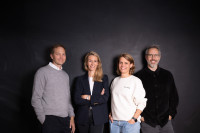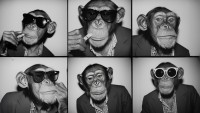Agency Model 2030 – Redefining Success
For a long time, size was synonymous with success. More employees. More offices. More structure. But that logic is fading.
Clients no longer count heads — they expect impact. Speed. Results.
The agency model of the future won’t be measured by how many people it employs, but by how intelligently it connects thinking, technology, and creativity. Those who keep selling hours will lose. Those who create impact will win.
Kim Notz
14. October 2025
For a long time, our industry followed a simple equation: the bigger the agency, the greater the success. More employees, more units, more international offices — that was the currency we used to measure ourselves. But that logic has expired. Clients no longer care how many people work at an agency. They want impact. Results. Speed.
Last week, I spoke with Christian Underwood, the founder of StrategyFrame — an almost fully automated strategy consultancy. His model is radical: lean, digital, scalable. He says headcount will no longer be a success factor. And he’s right. His consultancy delivers output that once required entire teams. It’s powered by proprietary software — and it’s already working with clients in our industry.
This is more than just a signal. It’s a glimpse of the future.
Moving from headcount to impact
We all know the old rhetoric: “We’re big, therefore we’re strong.”
But size is not a purpose in itself. It often slows processes down, makes structures rigid, and weighs down cost blocks. But clients don’t pay for complexity — they pay for impact.
By 2030, no one will ask: How many people work at your agency?
They’ll ask: How fast can you deliver results? How much can you improve my business? How innovative are you?
The classic “time for money” model won’t survive under this pressure. Those who only sell human hours will be overtaken by tools, automation, and AI.
Success will be measured by impact — not by timesheets.
Digital levers for business transformation
The future of agencies doesn’t lie in becoming tech companies themselves, but in intelligently integrating digital solutions into their services.
AI-powered tools are no longer add-ons — they are amplifiers: they make our thinking faster, our processes clearer, and our results more robust. The decisive factor isn’t whether software becomes the core of the business, but whether technology becomes an enabler of new forms of creative value creation — tailored to client needs.
And this is not a distant vision. Some agencies are already working with their own applications and agents that support both agency and client teams in their daily work. What used to be an add-on is becoming part of an expanded service portfolio — more efficient, more scalable, yet still creatively led.
This is where a new equilibrium emerges: Service + Product + Platform.
Not as a tech stack, but as a new interplay of thinking, compression, and amplification.
- Service: Our core remains strategic brainpower, creative excellence, and business understanding. That’s where value is created.
- Product: From that thinking emerge reusable modules — frameworks and playbooks — that make impact faster and more precise.
- Platform: Technology provides the infrastructure that carries, connects, and scales these ideas. Not as an end in itself, but as an amplifier of human creativity.
This evolution leads to a new understanding of our work.
This isn’t a tech stack. It’s an impact stack.
It starts with attitude and ends with impact.
The logic is shifting:
- from pure services to intelligently networked, hybrid models of strategy, creativity, and technology.
- from project-based work to continuous collaboration with shared success metrics.
- from billable hours to measurable impact.
This doesn’t change what we are — it changes how we work.
The shift is uncomfortable, but inevitable. Those who ignore it will remain stuck in the old “agency sells hours” model — where cost pressure is highest.
This new balance between thinking, system, and scale will not only change how agencies operate, but also how we define creativity itself.
Creativity is getting more connected
The “Full Service vs. Boutique” debate is a relic.
The future lies in integration. Agencies will become ecosystems: modular in structure, built on deep specialist expertise that is orchestrated — enhanced by platforms, tools, and AI systems. The art is not in doing everything yourself, but in integrating the best.
But integration also means diversity in creative thinking. Too often, we — or our clients — have already locked into specific formats at the briefing stage, before the idea even exists. Yet true creativity begins with openness: with the freedom not to know whether the best solution is a campaign, a PR stunt, an immersive experience, a brand partnership, or a product innovation. Part of creation is discovering that path.
Creativity in 2030 will therefore need not only new technologies, but also greater diversity in creative outputs — and the ability to connect the right dots. Connecting the dots will become a core skill across crafts, disciplines, and partners. Because impact will no longer come from isolated disciplines, but from intelligent interlinking.
The agency model of 2030 will be less of a monolithic structure and more of a living collective: internal crafts, external partners and experts, plus software products. What matters is how intelligently and agilely it all works together.
Shifting client expectations
Clients are evolving just as we are.
They no longer want PowerPoint battles, endless meetings, or opaque billing models. They expect:
- Strategic consulting: deep business understanding and a focus on impact.
- Agility and flexibility: lightweight processes that can adapt quickly and pragmatically to change.
- Efficiency: results delivered faster, based on reliable data.
- Individualization: automation without one-size-fits-all solutions.
- Transparency: clarity on which services come from humans, tools, or AI.
But technology alone won’t solve this. Trust, personal relationships, and a deep understanding of the client’s business will become more important — not less.
Where AI accelerates processes, people are needed to create meaning, frame decisions, and build relationships.
The best agencies of 2030 will be those that bring together digital business models and human connection — using technology smartly to strengthen empathy, strategy, and trust, not replace them.
This means agencies must reinvent themselves — not just as creative partners, but as architects of new connections between strategy, technology, and attitude.
Rethinking leadership
This shift is also transforming leadership.
Teams are becoming smaller, more flexible, often interdisciplinary and international. AI won’t just be an assistant — it will become part of the team.
This requires leaders to embrace:
- Orchestration instead of micromanagement
- Product thinking instead of project thinking
- A spirit of experimentation instead of control
The role of leadership will be to create meaning.
Because the more technology takes over the work, the more important the question becomes: What do we actually stand for as an agency?
Attitude and values are no longer just “employer branding” — they’re becoming critical to culture, attractiveness, and ultimately, market value.
From agency to a value ecosystem
The agency of 2030 will be a vital value creation ecosystem.
Consulting, creativity, and technology will be connected in ways that make them both scalable and resilient.
This means:
- We need to invent new business models, not just optimize existing ones.
- We need to think in terms of our own products.
- And we need the courage to integrate young founders with bold ideas into our way of thinking. Because the future rarely emerges from established structures — it comes from those who have nothing to lose.
Agencies that take this step will secure their future.
Those that cling to old headcount thinking will become irrelevant.
What now?
The agency model of 2030 confronts us with a simple but uncomfortable choice:
Do we want to remain service providers paid by the hour?
Or do we want to become co-creators who drive real impact?
What once seemed like the advantage of scale is increasingly becoming a legacy that slows down transformation.
Agile, independent systems have the upper hand — because they can face change with openness.
In the future, success won’t be measured by size, but by impact.
The future doesn’t belong to the biggest agencies.
It belongs to the smartest ones.





